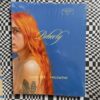
Edwin Bower Hesser: Nude Reflection (vintage photograph 1920s)
Edwin Bower Hesser, vintage 4×5″ glossy photo mounted to cardstock taken from the photographers private order album. The image is very fine and delicately sepia toned. A great petite boudior image, classic 1920s pose and natural site.
”
EDWIN BOWER HESSER (1893-1962)
Hesser belonged to the generation of photographers who saw the marriage of image and performance as the future of the art. Born in New Jersey and apprenticed in photography in New York City, Hesser became smitten with the potentials of the art form. Prior to World War I he toured Northeastern theaters with J. Townsend Russell in a series of ‘picture readings’ illustrating Longfellow’s ‘Tales of a Wayside Inn. Townsend recited the poem accompanied by a string orchestra while illustrative photographs were projected on the screen. In 1913, Hesser introduced Roald Admundsen, the first man to reach the south pole, to New York audiences, presenting motion pictures to illustrate the trek. Using family money he incorporated on February 3, 1915, the Hesser Motion Picture Corporation with a capitalization of 50K$. the Later in the year, he was in Atlanta opening the Hesser School For Motion Picture Acting. With America’s entry into World War I, Hesser joined the U. S. Army Signal corps with the rank of Captain and oversaw land photography. While in the service a scenario composed by Hesser, “The Freedom of the World,” was made in 1918 into a semi-documentary feature film by Goldwyn. After the armistice, Hesser decommissioned, set up a photographic Studio in Manhattan employing as his assistant a talented Italian, Nino Vayana, to oversee production. He was drawn to the world of movies and worked as a contract photographer for numbers of silent stars based in New York, particularly Norma Talmadge, Irene Castle, and Marion Davies. A fire in 1922 destroyed his production facilities and his stock of early negatives. He began to make regular trips to the west coast for photographic sessions with Hollywood stars, and finally moved his pase of operations to the West Coast. By 1923 he realized that the real money in photography lay in periodical publication, not in the service of film publicity offices or stage PR men. He saw a particularly opportunity in the subject which the 1920s stage explored with great daring, but the screen, even in pre-code days, could not pursue: female undress. Throughout the late 1920s, he published EDWIN BOWER HESSER’S ARTS MONTHLY, and other titles, exploiting the association betweens art and nudity, and sold it to an anonymous readership of ‘art students.’ The magazine published work by Alfred Cheney Johnston, John De Mirjian, George DeBarron, and Strand Studio. Hesser’s exploration of the netherworld of publishing brought him in contact with the Hollywood underworld. In 1928 he was arrested for suspicion of narcotics peddling, battery, and impersonating a police officer in connection with the death of starlet Helen St. Clair Evans, who was murdered by her husband Arthur. He was released, but the Depression shut down Hesser’s successful exercise in niche publishing. Fortunately for Hesser, he experiments with color photographic processes and his experience with mass reproduction of imagery made him attractive in the eyes of the NEW YORK TIMES, who hired him as a technician. Later in the decade he returned to California. Hesser continued to practice photography until the late 1940s placing occasional pieces with magazines. His photographic archive is stored in the special collections department of UCLA library.
A versatile artist whose plein air nudes of Showgirls in natural light became the academic standard for art photographers in the 1920s and whose portraits of movie actresses and stage stars were greatly influential images of glamour from 1925 to 1930. He was one of the few portraitist who regularly depicted sitters head on. His penchant for back-lighting so that hair seem lined with light, gave certain of his 1920s sitters a halo or aura. Expert at landscape photography, he often shot nudes in parks and glades. Possessed of an inquiring and entrepreneurial mind, he developed and patented a color process, “Hessecolor,” that intrigued mass circulation publishers during the 1930s, but did not prevail in the marketplace.” –David S. Shields
$ 500.00
Out of stock


